November/December 2018
Cats On A Hot Savannah
A great visit with Cheetahs and a cool Lion sighting brighten our days
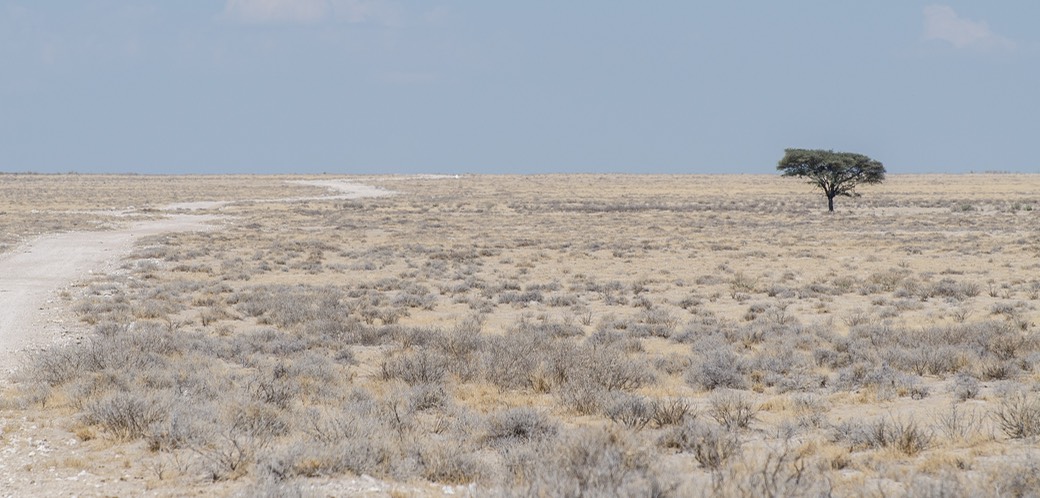
In mid November we ducked out of the Namibian interior to cool down for awhile along the Atlantic coastline. We lounged along the beach near Swakopmund and Walvis Bay, the only two real towns along the coast, although Henties Bay (or Hentiesbaai, as it still says on some maps and road signs), a little further north, is trying very hard to join in; they are revamping the center of town, and there are now cafes on every corner… we hear they are even considering paving the streets! Not the same little fishing village it was a few years back, it seems.
The heat in Namibia at this time of year, as we had suspected, is hard on us, and we have needed to change our plans somewhat to accommodate it. We are finding that we can manage for a few weeks, and then need to swing west to the coast for a week or so, to cool down and recharge our batteries. Having now recovered our cooler selves, we are PUMPED and ready to plunge back in, heading for new adventures.
Our big goal for this next spurt is to work our way north to Etosha National Park, up near the Angolan border. Everyone says it’s a great place, full of wild animals around every corner. Not a park to be missed. So off we went, primed for bear (no, not bear, dummy; lions and elephants and giraffe and zebras — stuff like that).
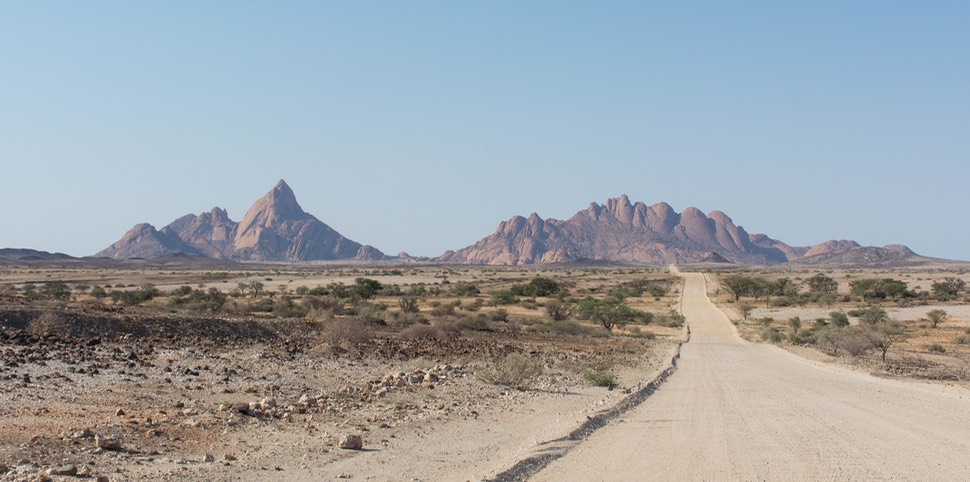
We picked a route that would wander through the Erongo Hills, up the middle of the African Escarpment past Omaruru and Otjiwarongo, and then head toward the eastern entry to Etosha. Got all that? There were ancient rock carvings to be explored in this part of the country, nice areas of rock formations, and a cheetah conservatory. A great plan.
Leaving the Swakopmund area, we trekked back east into the desert; our first stop was to visit Spitzkoppe, turning off the B2 west of Usakos. (Now stay with me here, you know you need to keep that Africa map handy!) it’s dry and quite warm inland, but cools off nicely at night thankfully; we enjoyed the evening light and the stars and some pretty nifty sunsets. Spitzkoppe is an inselberg, a particularly steep-sided mountain of a hill in the midst of nothingness; it’s an area of lovely rock formations and we got some great pictures. For some, Spitzkoppe is a hill; for others definitely a mountain. It sticks up out of the desert like a stranded ship, and is great for hiking and rock climbing. It’s very dramatic.
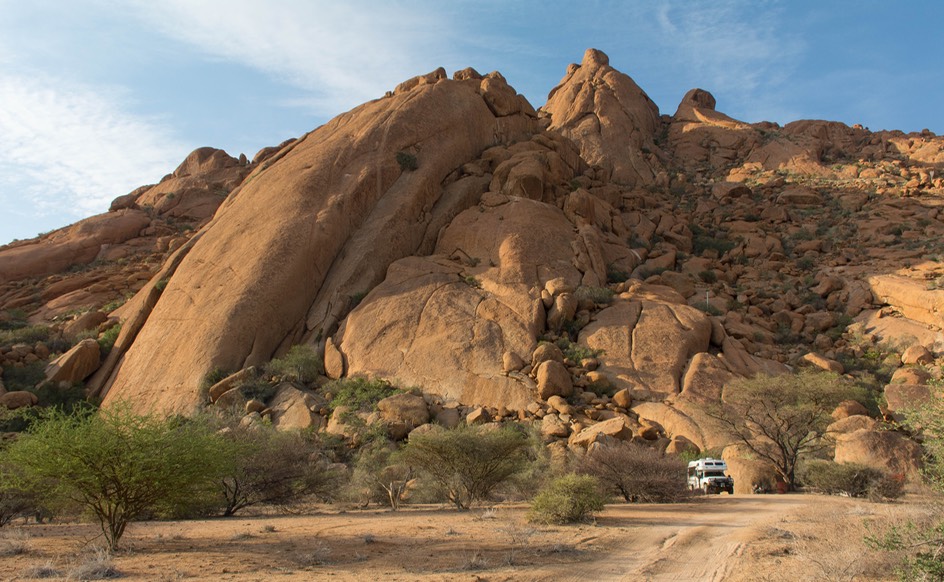
This area is a conservancy maintained by the locals, who do a good job. We camped up at about 1075 meters. There’s no electricity (we didn’t care), but plenty of hot water for open-air showers. We just loved them; if you’ve never taken a shower outside, under the sun and with the breezes floating around, you definitely need to do it — yes there are walls, silly, just no roof. We spent a day wandering around the mountain, checking out the various formations, visiting some ancient burial sites, and looking for wildlife. We shared our campsite with plenty of lizards and other small critters, including some Dassies like the ones we’d seen when we were down on the Cape. Cool.
One of the more famous rock engraving sites in the Erongo Mountains is Phillip’s Cave, located on private land owned by the Ameib Guesthouse. It seems you go onto their property, make arrangements to see the cave, and then hike in. Sadly, the gate to the property had a big sign on it saying it was closed until further notice. The rock art in Namibia is very famous; some of the engravings (and there are rock paintings as well) are over 6,000 years old. They were created by the San people (also known as Bushmen) but it seems we’ll have to go elsewhere to find some to see.
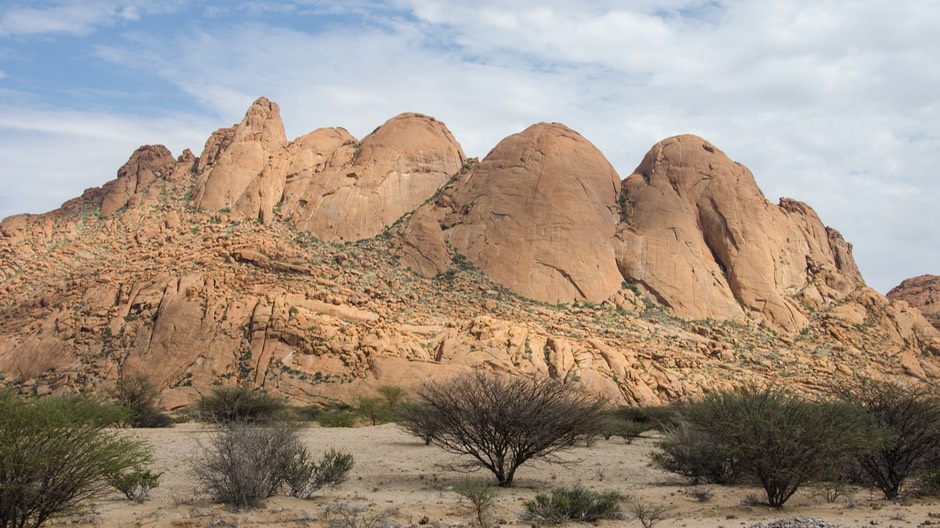
We had planned to stay that night at the Ameib Guesthouse, but that was out so we continued on along a dusty and rocky road. We were traveling near a land conservancy. The way things work in Namibia can sometimes be confusing. We have now learned that landowners, government entities, and people working the land in an area frequently come together to establish a conservancy. The purpose is to protect the land and things of value on it, allow for controlled tourism in the area, and together work to maintain the financial and environmental health of the locale.
After a couple of hours we entered the conservancy. There was no charge for driving through, and although we could not wild camp there, we had a list with several properties that provided camping places where we could stay. And this is what we did. We had information on a spot called the Omandumba Rest Camp. It had two very remote, isolated bush camp sites tucked away among boulders back in the hills. There was water there, toilets, and donkey showers (wood provided). We really enjoyed this remote spot; it was ever so much nicer than the towns we’d been staying in where the campsites might be nice, but they were behind hotels, crammed together, etc. We like remote, and there are lots and lots of these kinds of places in the Namibian bush.
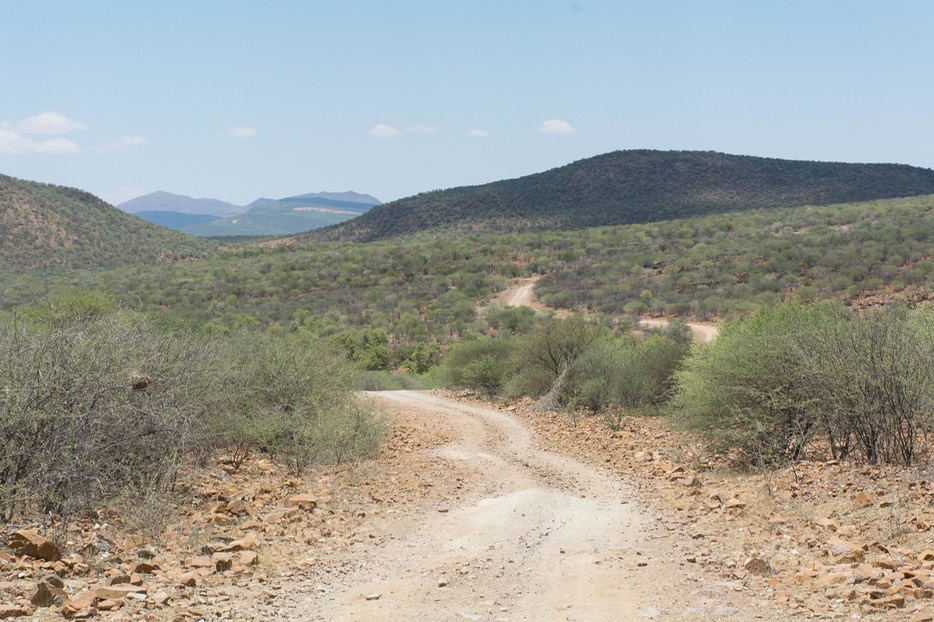
Finally moving on, we were interested in exploring more of the Erongo Mountain area, but soon found that the rough roads were more than we wanted to handle right now, especially since it was going to be one way in then turn around to take the same road back out. So we pulled in our horns a bit and headed back more into the mainstream, stopping in the regional town of Omaruru. This is a very nice town, making itself open and friendly to tourists. There are craft markets to explore and even a (reportedly) very nice bakery. Having recently left Swakopmund, even Rick didn’t feel the need for more bakery goodies if you can believe it. Maybe next time through.
In this area we were noticing that the vegetation was quite a bit more tropical. Palm trees, bougainvillea, gorgeous flamboyant trees in full bloom, lots of flowery shrubs, and trees with lots of green on them. And termite mounds, huge ones. It was a delightful change from the starkness of much of the desert. As our overall plan will take us further and further north, and we will slowly drop in elevation as we get closer to the Angolan border, we hope to see more. We shall see!
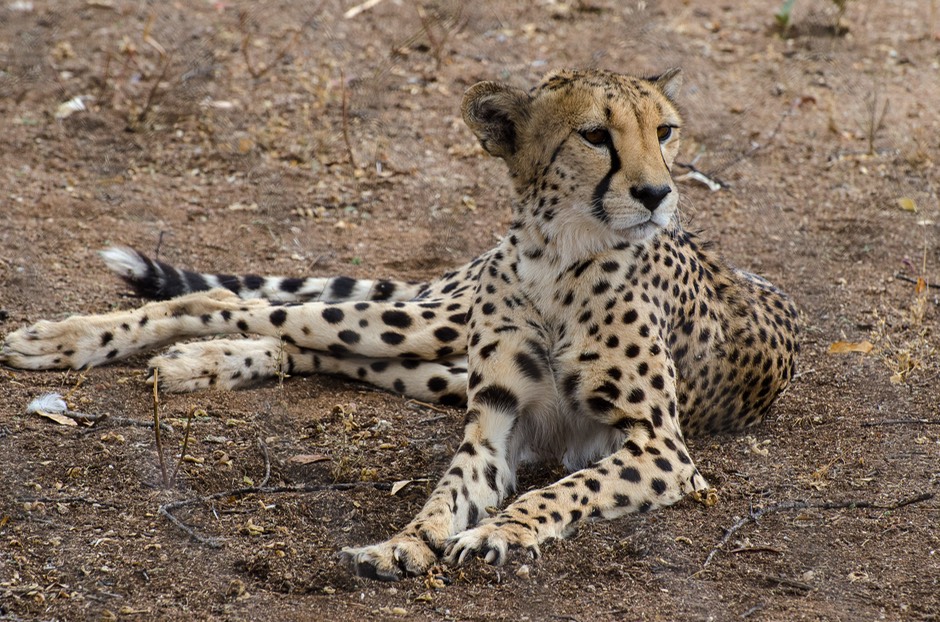
Our next target for exploring was near the town of Otjiwarongo. We stopped there for stocking up on supplies we’d not seen in a bit, and then headed about 25 miles east of town to the Cheetah Conservation Fund (CCF), highly recommended by several people as being a very interesting place to see cheetahs, and to learn all about them. We came, we saw, we learned and we really enjoyed ourselves.
The CCF is a lot of different things — a rescue center, a rehabilitation plan, educational programs for local farmers, a learning facility for the public (with a nice museum on site), a lodge, a teaching facility — you name it. There is even a goat farm on site. They make cheese and ice cream (and fudge — goat cheese fudge?? You Bet!!) Cheetahs are endangered, with only about 10,000 left in all of Africa, with roughly a third of them in Namibia. In part their falling numbers are because they are feared and hunted by farmers because they prey on the domestic herds. CCF works to teach the farmers that in fact Cheetahs kill far fewer sheep or goats than other predators like leopards or lions. The fact that Cheetahs hunt during daylight hours and not at night tends to make them more noticeable and also easier to kill.
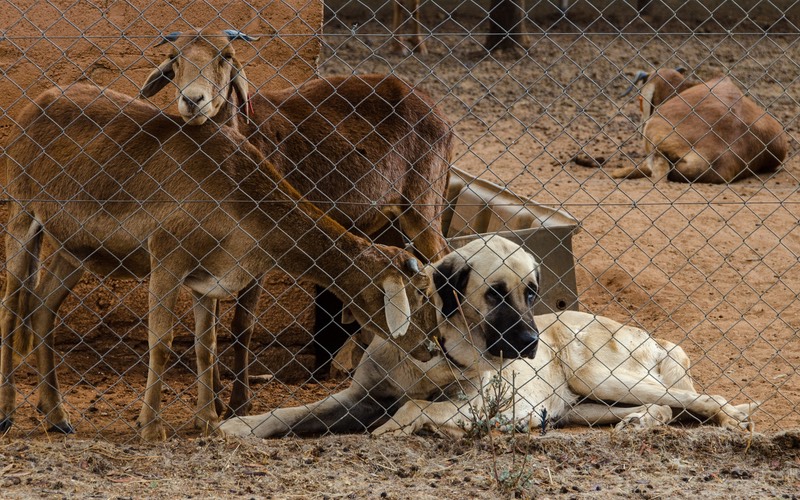
To further their outreach to farmers, CCF has developed a program where dogs are bred and trained on site to protect the domestic herds and scare the predators away. Hence the herds of goats also right here.
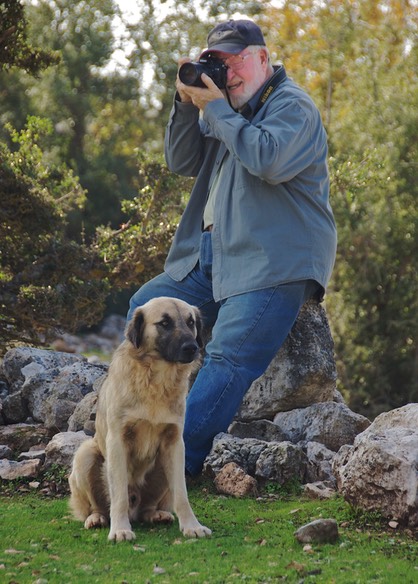
Now this is a really cool program and impressed us mightily with the thoughtfulness and sustainability of the idea. After a slow start in introducing the dogs to Namibia, CCF now raises about ten litters of dogs each year and has a long waiting list of farmers who want one. We were also immediately struck by the dogs themselves. They are Anatolian Shepherds and we recognized them from our time in Turkey, where these dogs have been used to guard domestic herds for 5,000 years.
Goats are always fun to watch, and we were able to see the youngsters being fed on an assembly line sort of process. Add in the big dogs lazing about with goats poking at them and laying alongside was just perfect. This was one of those ‘wow’ moments when something we’ve experienced during our own travels lends added meaning to what we are learning in a different country. The dog on the right is at CCF in Namibia in 2018, while the photo on the left was taken in Turkey in 2012. Cool.
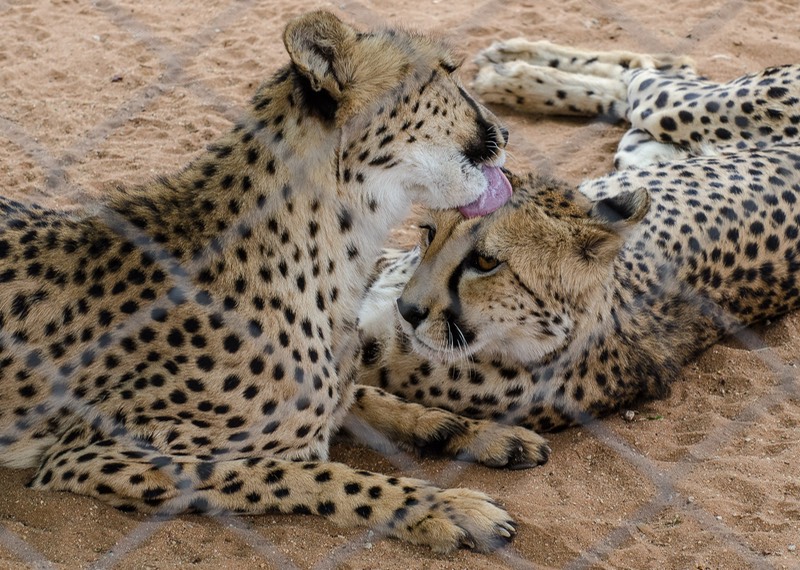
We really enjoyed the cheetahs. They lounged; they wrestled with each other; they carefully made sure to check every bowl at dinner time to be sure nothing got left behind; they licked each other’s faces; they stretched; they even purred. Just great big cats. Cheetahs rule! The purring was especially neat. We heard one of the first cats we saw doing it and we just looked at each other in wonder. Later we learned that the Cheetah is the largest of the cats that exhibits this most special and essentially feline behavior and we loved them even more for it.
We spent a lot of time talking to the interns and employees at the park. They even invited us to have dinner with them. They came from lots of different countries — as well as many locals of course — some just for a short period and some for several years. Many start as interns and then apply for paid positions so they can return. Each person was really happy to be there, worked very hard in high heat, and hoped to stay for a long, long time. They mostly were in their twenties and early thirties, some in professional jobs and some just there to do the dirty work. The project had been conceived of and was run by an American woman, a zoologist, who had begun things back in 1990, directly after Namibia became an independent country. It’s a wonderful place and we are big fans; you can check it out at cheetah.org. You’ll also want to be sure to see more of our photos on the photo page for this story.
Finally tearing ourselves away and wanting to move on further north to Etosha NP, we hopped in the truck the next morning, and drove on up through Tsumeb and into the eastern entry to Etosha National Park, where we explored most of the park over the next four days.
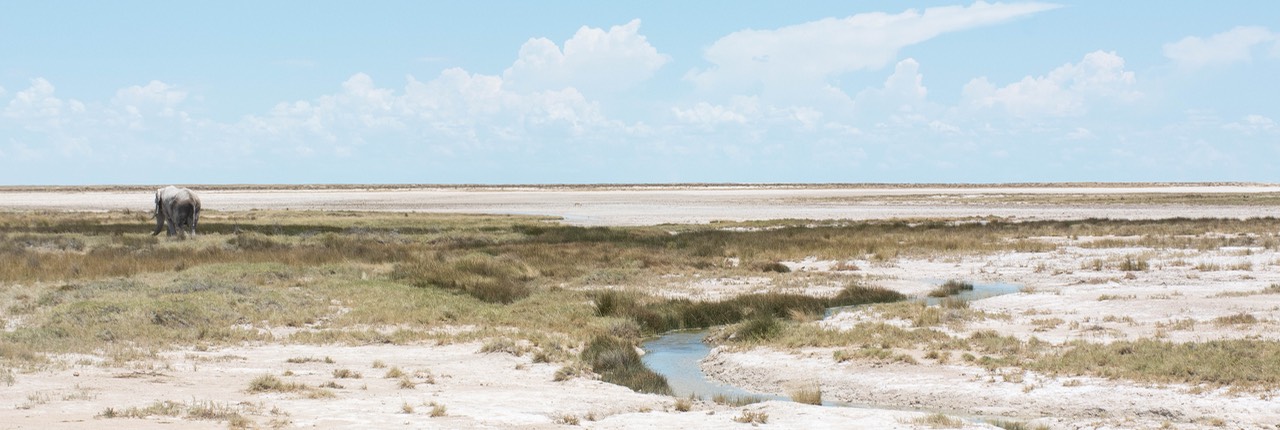
Our time at Etosha was difficult for us, but ultimately extremely rewarding. The roads were very bad, and you had to drive quite long distances, making it hard for Rick to enjoy the experience. It was very hot, particularly in the eastern part of the park, which is centered on the huge open saline pan (etosha means “great white place” among other things) which covers much of the area in white rock with no trees. It was too hot to cook; we just ate what was in the fridge, which was quite unhappy at the high temps. It was also expensive and the campings were dusty and some of the facilities not up to snuff and it was hard to get good information on where to go to best see the animals.
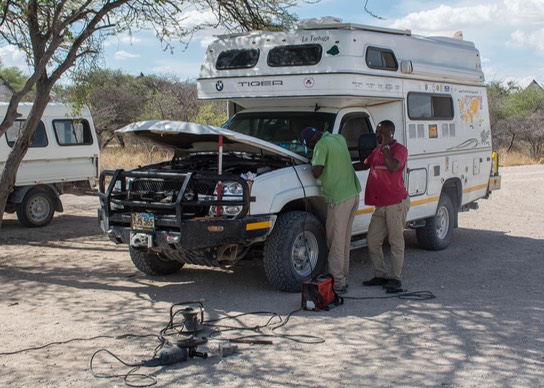
So here’s Rick dealing with the heat and muttering about the too high cost of the camp sites and the lousy roads; and then the hood on the truck broke again. Merde! Out comes the roll of duct tape to secure the hood — again. We love our Chevy, don’t ever think we don’t, but it does have its weak points and the hood hinges are right up there when you do the amount of rough road driving we do. First in Argentina ten years ago, then twice in Australia last year and now again. Bah! When we arrived at our evening’s camp, which happened to be Okaukuejo, the main camp in Etosha, we asked about the chances of a welder. Within about ten minutes two guys were working away and after a bit we were once again good to go. With all the negatives, that really stood out for us — how often can you drive into a campground in a remote part of the world and “You need a welder? Yes, of course, I’m getting him on the phone right now”. Such a great thing to have happen! As we’ve said frequently, as much of a nuisance as it can be at the time, if things didn’t break we’d miss out on a lot of positive experiences.
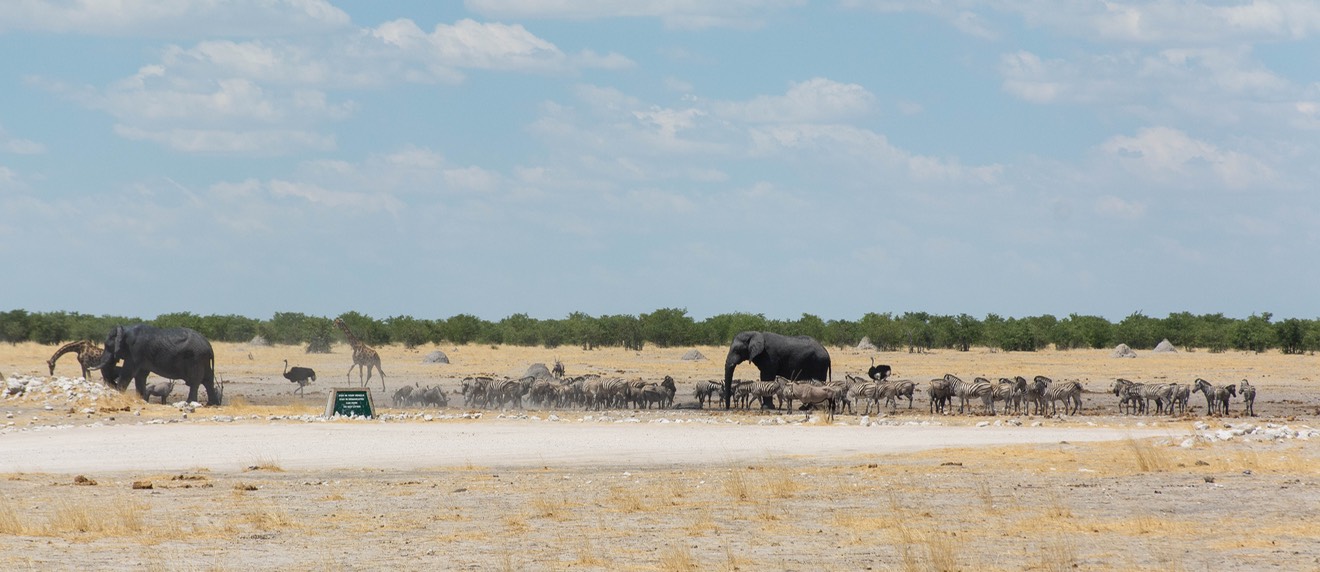
So Etosha presented us with some difficulties, but in the end the good stuff outweighed the bad as it generally does. Etosha is famous for its large groups of animals hanging out around the waterholes. We saw lots of them, and we’ve got the pictures to prove it. In addition to all the animals we saw along the road each day, the camping areas in the park all have a waterhole within easy walking distance, and we’d walk over, settle in and wait for them to show up. And they always came. Zebras by the score along with springbok, black faced impala — the first of these we’ve seen — hartebeest, wildebeest, kudu, oryx, ostrich, lots of giraffe and the odd elephant or two as well.
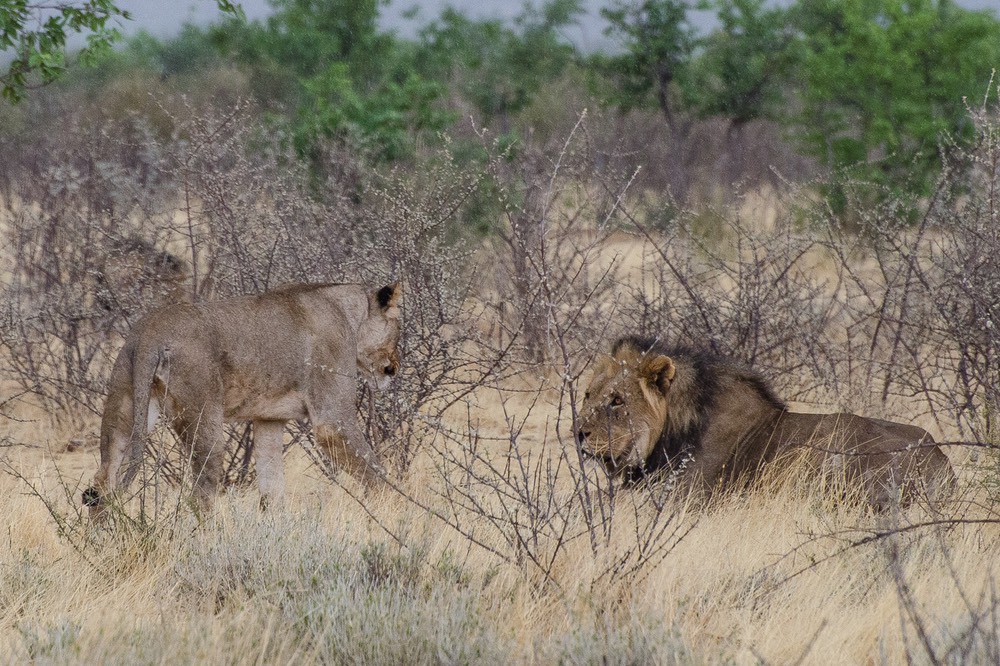
And then, on our last morning, as we were driving toward the park’s western exit, Rick murmured “There’s a lion over there.” And wow, what a trip! Lion walks in, settles down, lioness joins him, they talk a bit, she decides he needs to earn his keep; so after a leisurely stretch she gets up and flits her tail in his face and then walks off. He looks, he sniffs, he says “Hmmmm” then gets up after a minute and trots off after her down the trail. End of story, at least for us; we were thrilled. We got great shots of them, of her flirting with him, and the look in his eyes as she passed by. Simply super. Check out the photo gallery for the entire sequence.
Leaving Etosha we collapsed for a few days at a terrific lodge called Oppi Koppi, on the edge of a tiny hamlet called Kamanjab, an hour or so south of the park exit. This was a very special place. It is owned by a couple who have created a lovely guest house and grounds. In addition, there is a camping area set aside for folks traveling through. But what makes it special for us is that the camping is free for overlanders — international travelers coming through in their own vehicles from overseas. We were made very welcome and enjoyed dinner in the restaurant two nights running to show our appreciation.
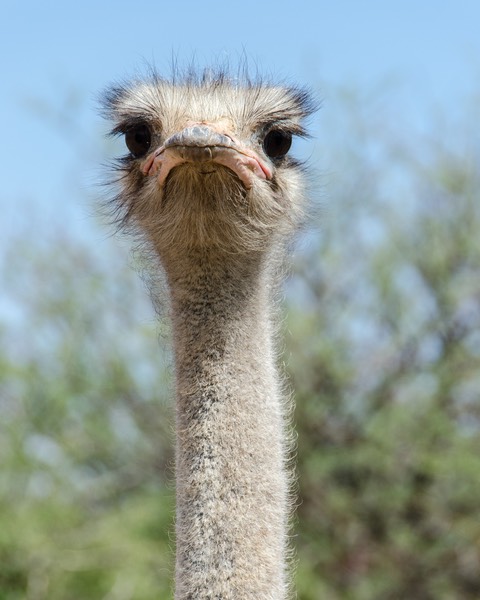
The only unexpected event at Oppi Koppi was an encounter with the local ostriches. The fence surrounding the camping area was right along the back of our site and very close; actually butting right up to the covered enclosure for our picnic table and washing area. Rick had a bit of a disagreement about who actually owned the clothes line we had strung to hang out some laundry. After a certain amount of discussion back and forth, and an interesting tug o’war, Commodore Howe retrieved the length of cord in question, and the bird stalked off. Rick had prevailed. It was kind of interesting to watch, although an ostrich is a whole lot bigger and tougher than you might imagine!
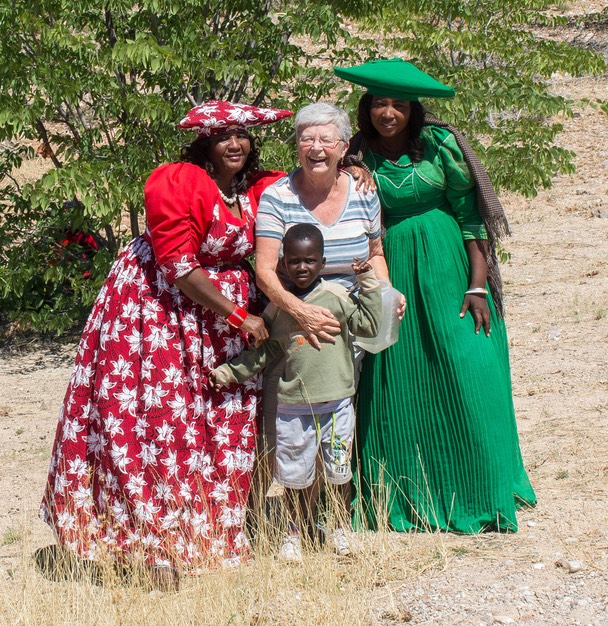
Heading south from Kamanjab we were making for Twyfelfontein, a very historic site filled with ancient rock engravings. Along the way, we pulled over beside the road to see if we could help a couple of fellows who were lying on their backs under their small truck. They were delighted to have us come by. They needed a jack of the right size — and we had precisely the right tools for the job.
While Rick helped them get the jack settled, I noticed that there were a couple of women sitting under a tree so I went to see if they needed water or food. They’d been passengers riding in the now immobile truck, and graciously and gratefully accepted my offerings. They were members of the Herero tribe, in traditional dress. In all, there were four women, a child, and a village elder. Amongst us we had a few words of English, but not much else. They graciously allowed us a few pictures, then a local stopped by to help with the truck and they finished up with our jack, so we hit the road again. It was a nice experience.
Finally reaching Twyfelfontein, late in the afternoon, we settled down for an early evening so we could get a good start out to the rock etchings before it got too hot the next day. The only excitement during the evening was an erroneous identification of a bellowing cow parked nearby for the night — as possibly something more exotic. No harm, no foul and a good laugh was shared.
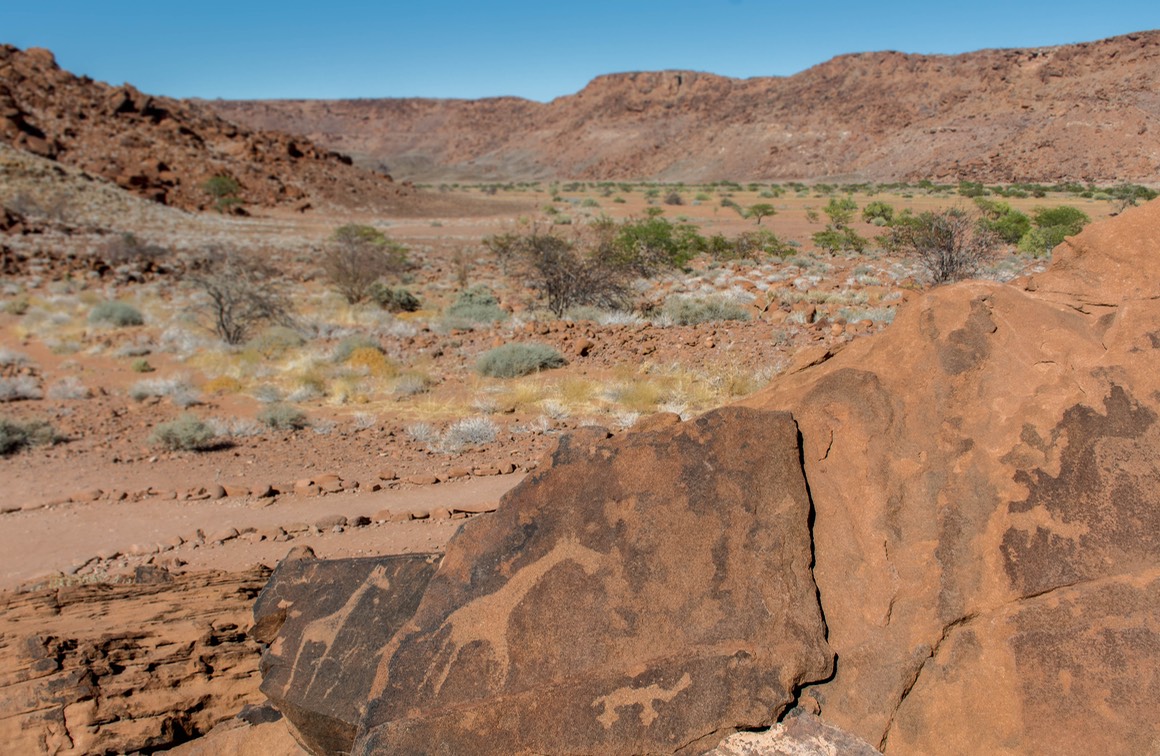
Early the next morning we headed out to see the art work. It was in a beautiful valley, and was absolutely fantastic; I had a splendid time. I had my own guide (you cannot go on your own), who was very helpful in aiding this old lady climb over some pretty steep and difficult places and who thoroughly explained everything I was seeing and didn’t hustle me along; he gave me plenty of time to absorb it all. Makes me want to see more — soon.
Leaving the rock engravings, we decided to head back down to the coast for a bit of a cool down. The welding repair done to the truck’s hood needed adjustment, we had some new engine sounds to be investigated (exhaust leak if you’re keeping score), the rattle from the LPG tank area was getting more noticeable, and we wanted some of the quite amazing fish and chips available from the wagon parked on the strand in Swakopmund. So off we went.
*********
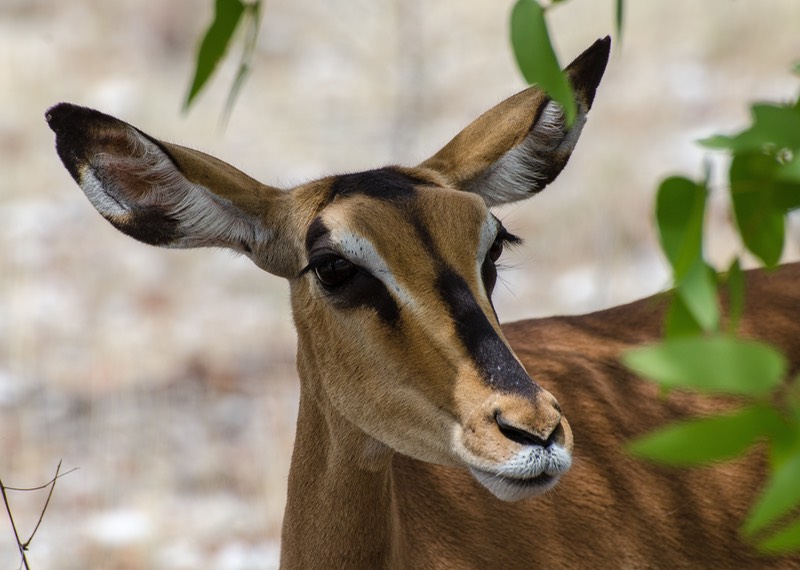
It’s now a week later, the fridge is working much better, we are cooled off again, the truck is happier in a couple of areas and we are ready to head back out. The temperatures have been delightful here along the water, and the fog lifts from time to time to give us some sun. As Christmas approaches the crowds are growing and the prices have risen in tandem; the surf’s up, the boogie boards are flying through the air, and all is well. By the way, the fish and chips from that wagon on the jetty is probably the best we’ve ever had.
We hope to send this to you from Cape Cross (if the lodge here has enough wifi juice), about 50 km north of Henties Bay along the Skeleton Coast. The fur seal colony is here, and we promise to go see them (and take pictures) before we continue on. We’ve got about a month left before we fly home for a bit, and lots more to see!! We’ll be heading up through Skeleton Coast NP, then inland to Palmwag, then up through Warmquelle and Opuwo to Epupa Falls on the Angolan border. Supposed to be some nice country up there. We’ll be sure to let you know.
So best wishes for the holidays, don’t eat too much Christmas cake, and good luck in 2019.
Rick and Kathy and our very own big cat, the Tiger
Go to the Photo Page to see more pictures from this story,
and to the separate page for more pictures from Etosha National Park